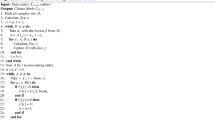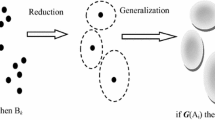Abstract
Rule-based modeling is a useful approach in modeling both complex nonlinear and non-numeric systems, e.g. having linguistic information. However, modeling complex systems in big data era brings new challenges for conventional rule-based modeling, such as high computation overhead and low representation ability of rule. To address these problems, this paper proposed an advanced rule-based modeling method-based DBSCAN-inspired granular descriptors. First, to understand the essential characteristics of data and enhance rules’ representation ability, data structures are obtained by DBSCAN clustering algorithm, which has high flexibility at coping with diverse geometry. Second, numerous granular descriptors are constructed in the refined representation of data structures and used for fuzzy rule formation. This granular computing process could effectively reduce computation overhead of big data analysis. Finally, the proposed rule-based model consists of fuzzy rules and interval outputs, which are resulted from structural granular descriptors and justifiable granulating respectively. Experimental studies concerning synthetic data and publicly available data illustrated that the proposed method can achieve prior performance on both modeling and time consuming than conventional rule-based modeling via FCM. Therefore, it is verified the developed approach is feasible and useful to be applied in modeling real complex engineering systems.










Similar content being viewed by others
Data availability
The data that support the findings of this study are available from UCI website (https://archive.ics.uci.edu/ml/datasets.php)
References
Al-Hmouz R, Pedrycz W, Balamash AS, Morfeq A (2018) Hierarchical system modeling. IEEE Trans Fuzzy Syst 26(1):258–269
Brooks TF, Pope DS, Marcolini MA (1989) Airfoil self-noise and prediction, vol 1218. National Aeronautics and Space Administration, Office of Management, Scientific and Technical Information Division, Washington, DC
Chen H, Wen J, Pedrycz W, Wu G (2018) Big data processing workflows oriented real-time scheduling algorithm using task-duplication in geo-distributed clouds. IEEE Trans Big Data 6(1):131–144
Chen NN, Gong XT, Wang YM, Zhang CY, Fu YG (2021) Random clustering forest for extended belief rule-based system. Soft Comput 25(6):4609–4619
Cui Y, Hanyu E, Pedrycz W, Li Z (2019) Augmentation of rule-based models with a granular quantification of results. Soft Comput 23(23):12745–12759
Ester M, Kriegel H-P, SanderJ, Xu X (1996) A density-based algorithm for discovering clusters in large spatial databases with noise. In: Proceedings of 2nd international conference on knowledge discovery and data mining (KDD), pp 226–231
Güngör E, Özmen A (2017) Distance and density based clustering algorithm using Gaussian kernel. Expert Syst Appl 69:10–20
Hanyu E, Cui Y, Pedrycz W, Li Z (2019) Enhancements of rule-based models through refinements of fuzzy C-means. Knowl-Based Syst 170:43–60
Hu X, Shen Y, Pedrycz W, Wang X, Gacek A, Liu B (2021a) Identification of fuzzy rule-based models with collaborative fuzzy clustering. IEEE Trans Cybern 52(7):6406–6419
Hu X, Shen Y, Pedrycz W, Li Y, Wu G (2021b) Granular fuzzy rule-based modeling with incomplete data representation. IEEE Trans Cybern 52(7):6420–6433
Huang H, Liu F, Zha X, Xiong X, Ouyang T, Liu W, Huang M (2018) Robust bad data detection method for microgrid using improved ELM and DBSCAN algorithm. J Energy Eng 144(3):04018026
Ienco D, Bordogna G (2018) Fuzzy extensions of the DBSCAN clustering algorithm. Soft Comput 22(5):1719–1730
Jiang GJ, Chen HX, Sun HH, Yazdi M, Nedjati A, Adesina KA (2021) An improved multi-criteria emergency decision-making method in environmental disasters. Soft Comput 25:10351–10379
Kerr-Wilson J, Pedrycz W (2020) Generating a hierarchical fuzzy rule-based model. Fuzzy Sets Syst 381:124–139
Khashman A, Akpinar P (2017) Non-destructive prediction of concrete compressive strength using neural networks. Procedia Comput Sci 108:2358–2362
Liu S, Pedrycz W, Gacek A, Dai Y (2018) Development of information granules of higher type and their applications to granular models of time series. Eng Appl Artif Intell 71:60–72
Mamaghani AS, Pedrycz W (2020) Structural optimization of fuzzy rule-based models: towards efficient complexity management. Expert Syst Appl 152:113362
Ouyang T, Pedrycz W, Pizzi NJ (2019a) Record linkage based on a three-way decision with the use of granular descriptors. Expert Syst Appl 122:16–26
Ouyang T, Pedrycz W, Reyes-Galaviz OF, Pizzi NJ (2019b) Granular description of data structures: a two-phase design. IEEE Trans Cybern 51(4):1902–1912
Ouyang T, Pedrycz W, Pizzi NJ (2019c) Rule-based modeling with DBSCAN-based information granules. IEEE Trans Cybern 51(7):3653–3663
Pedrycz W (2021) Federated FCM: clustering under privacy requirements. IEEE Trans Fuzzy Syst 30(8):3384–3388
Pedrycz W, Homenda W (2013) Building the fundamentals of granular computing: a principle of justifiable granularity. Appl Soft Comput 13(10):4209–4218
Pedrycz W, Reformat M (1997) Rule-based modeling of nonlinear relationships. IEEE Trans Fuzzy Syst 5(2):256–269
Rosenow J, Kern F, Rogge K (2017) The need for comprehensive and well targeted instrument mixes to stimulate energy transitions: the case of energy efficiency policy. Energy Res Soc Sci 33:95–104
Shen J (2016) Real-time superpixel segmentation by DBSCAN clustering algorithm”. IEEE Trans Image Process 25(12):5933–5942
Soto J, Castillo O, Melin P, Pedrycz W (2019) A new approach to multiple time series prediction using MIMO fuzzy aggregation models with modular neural networks. Int J Fuzzy Syst 21(5):1629–1648
Srivastava V, Biswas B (2018) Mining on the basis of similarity in graph and image data. In: International conference on advanced informatics for computing research. Springer, Singapore, pp 193–203
Vranješ M, Rimac-Drlje S, Vranješ D (2018) Foveation-based content adaptive root mean squared error for video quality assessment. Multimed Tools Appl 77(16):21053–21082
Wang D, Pedrycz W, Li Z (2016) Design of granular interval-valued information granules with the use of the principle of justifiable granularity and their applications to system modeling of higher type. Soft Comput 20(6):2119–2134
Xu J, Wang G, Li T, Pedrycz W (2017) Local-density-based optimal granulation and manifold information granule description. IEEE Trans Cybern 48(10):2795–2808
Zhou Y, Chang L, Qian B (2019) A belief-rule-based model for information fusion with insufficient multi-sensor data and domain knowledge using evolutionary algorithms with operator recommendations. Soft Comput 23(13):5129–5142
Zhu X, Pedrycz W, Li Z (2018) Granular models and granular outliers. IEEE Trans Fuzzy Syst 26(6):3835–3846
Acknowledgements
This research is support by JSPS Grant-in-Aid for Early-Career Scientists (Grant Number 22K17961).
Funding
This research is supported by JSPS KAKENHI Grant JP22K17961.
Author information
Authors and Affiliations
Corresponding author
Ethics declarations
Conflict of interest
Authors declare that there is no conflict of interest.
Ethical approval
This article does not contain any studies with human participants or animals performed by any of the authors.
Additional information
Publisher's Note
Springer Nature remains neutral with regard to jurisdictional claims in published maps and institutional affiliations.
Rights and permissions
Springer Nature or its licensor holds exclusive rights to this article under a publishing agreement with the author(s) or other rightsholder(s); author self-archiving of the accepted manuscript version of this article is solely governed by the terms of such publishing agreement and applicable law.
About this article
Cite this article
Ouyang, T., Zhang, X. DBSCAN-based granular descriptors for rule-based modeling. Soft Comput 26, 13249–13262 (2022). https://doi.org/10.1007/s00500-022-07514-w
Accepted:
Published:
Issue Date:
DOI: https://doi.org/10.1007/s00500-022-07514-w




